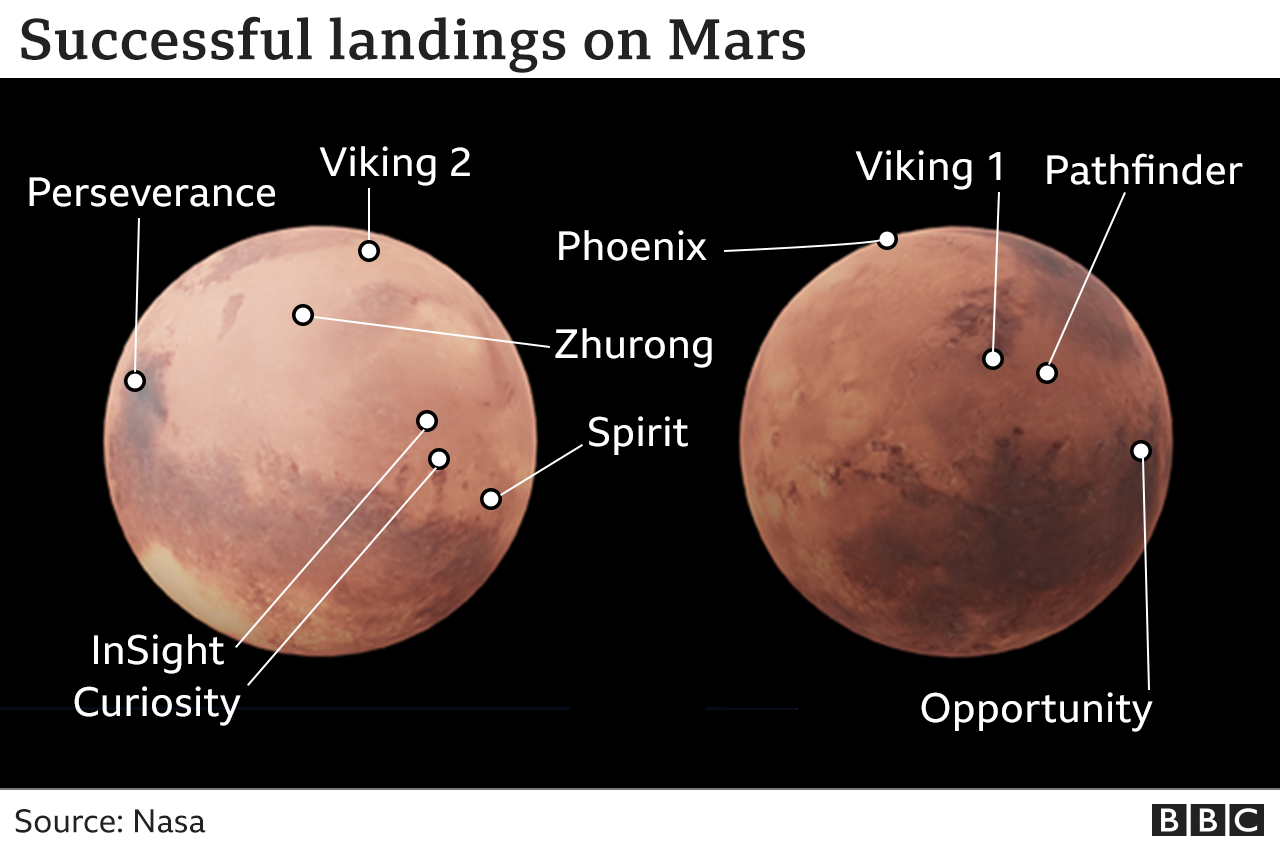15.05.2021
Tianwen-1’s lander and Zhurong Mars Rover with the team. President Xi sent his congratulations on the successful landing.
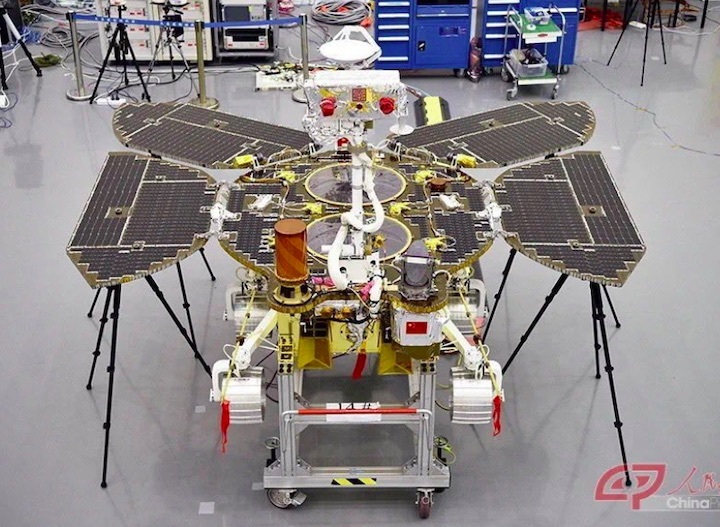
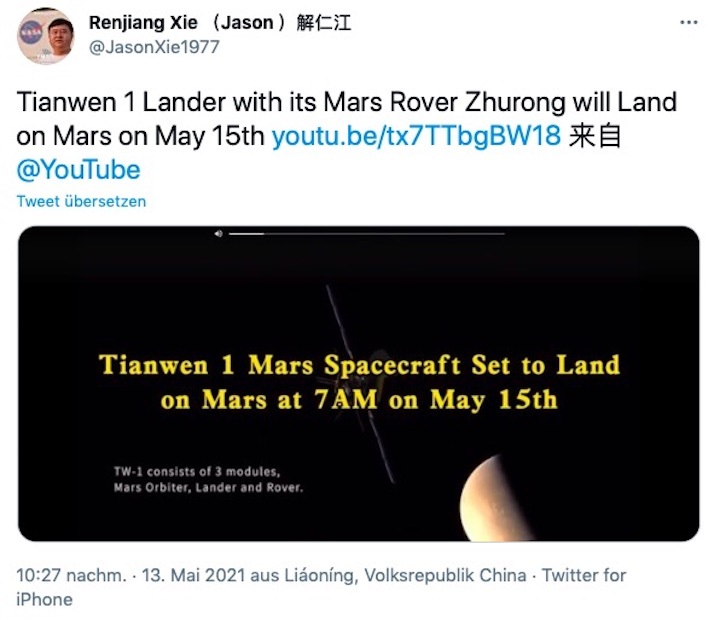
Quelle: Twitter
+++
Chinesische Sonde landet erstmals auf dem Mars

China ist erstmals eine Landung auf dem Mars gelungen. Das Landemodul des chinesischen Raumschiffes „Tianwen-1“ setzte am Samstagmorgen mit dem Rover „Zhurong“ an Bord auf der Oberfläche des Roten Planeten auf, wie die staatliche Nachrichtenagentur Xinhua berichtete.
„Tianwen-1“ war im vergangenen Juli von der Erde aufgebrochen und hatte im Februar die Mars-Umlaufbahn erreicht.
Die chinesische Mission ist eine von drei Flügen zum Mars, die im vergangenen Sommer von der Erde gestartet waren. Auch die Vereinigten Arabischen Emirate und die USA hatten damals Raketen Richtung Mars geschickt. Der US-Rover „Perseverance“ war bereits im Februar gelandet.
Bislang haben es nur die USA geschafft, Erkundungs-Fahrzeuge auf dem Roten Planeten zum Einsatz zu bringen. Der Sowjetunion gelang in den 70er-Jahren zwar eine Landung, es wurde aber sofort der Kontakt zu der Sonde verloren. Der Flug zum Roten Planeten und die Landung gelten als äußerst schwierig. Von vorausgegangenen Landeversuchen waren nur etwa die Hälfte erfolgreich.
Läuft nun alles nach Plan, soll der nach dem chinesischen Feuergott benannte Rover „Zhurong“, der in der Region Utopia Planitia aufsetzte, erwachen und mindestens drei Monate lang arbeiten und Untersuchungen durchführen. Der Rover wiegt etwa 240 Kilogramm. Er hat sechs Räder und vier Sonnenkollektoren und kann sich auf der Marsoberfläche mit 200 Metern pro Stunde bewegen. Der Rover trägt wissenschaftliche Instrumente mit sich, mit denen etwa Informationen über die Zusammensetzung der Planetenoberfläche, die geologische Struktur und das Klima gesammelt werden sollen.
Im Februar war der US-Raumfahrtbehörde Nasa die Landung ihres Mars-Rovers „Perseverance“ mit dem ultraleichten Mini-Hubschrauber „Ingenuity“ auf dem Roten Planeten geglückt. „Ingenuity“ hatte dann im April seinen ersten historischen Flug auf dem Mars absolviert.
Quelle: Bild
+++
China succeeds in first Mars landing

The graphic simulated image taken on May 15, 2021 shows China's probe landing on Mars. The lander carrying China's first Mars rover has touched down on the red planet, the China National Space Administration (CNSA) confirmed on Saturday morning. It is the first time China has landed a probe on a planet other than Earth. (Xinhua/Jin Liwang)
BEIJING, May 15 (Xinhua) -- The lander carrying China's first Mars rover has touched down on the red planet, the China National Space Administration (CNSA) confirmed on Saturday morning.
It is the first time China has landed a probe on a planet other than Earth.
"The Mars exploration mission has been a total success," Zhang Kejian, head of the CNSA, announced at the Beijing Aerospace Control Center.
After the success was confirmed, the control center in Beijing was filled with cheers and applause.
"It's another important milestone for China's space exploration," he said.
The Tianwen-1 probe touched down at its pre-selected landing area in the southern part of Utopia Planitia, a vast plain on the northern hemisphere of Mars, at 7:18 a.m. (Beijing Time), the CNSA announced.
It took ground controllers more than an hour to establish the success of the pre-programmed landing. They had to wait for the rover to autonomously unfold its solar panels and antenna to send the signals after landing, and there was a time delay of more than 17 minutes due to the 320-million-km distance between Earth and Mars.
Tianwen-1, consisting of an orbiter, a lander and a rover, was launched from the Wenchang Spacecraft Launch Site on the coast of southern China's island province of Hainan on July 23, 2020. It was the first step in China's planetary exploration of the solar system, with the aim of completing orbiting, landing and roving on the red planet in one mission.
The name Tianwen, meaning Questions to Heaven, comes from a poem written by the ancient Chinese poet Qu Yuan (about 340-278 BC). China's first Mars rover is named Zhurong after the god of fire in ancient Chinese mythology, which echoes with the Chinese name of the red planet: Huoxing (the planet of fire).
The spacecraft entered the Mars orbit in February after a journey of nearly seven months through space, and spent more than two months surveying potential landing sites.
In the early hours of Saturday, the spacecraft began to descend from its parking orbit, and the entry capsule enclosing the lander and rover separated from the orbiter at about 4 a.m.
After flying for approximately three hours, the entry capsule hurtled toward the red planet and entered the Mars atmosphere at an altitude of 125 km, initiating the riskiest phase of the whole mission.
First, the specially designed aerodynamic shape of the entry capsule decelerated with the friction of the Martian atmosphere. When the velocity of the spacecraft was lowered from 4.8 km per second to about 460 meters per second, a huge parachute covering an area of about 200 square meters was unfurled to continue reducing the velocity to less than 100 meters per second.
The parachute and the outer shield of the spacecraft were then jettisoned, exposing the lander and rover, and the retrorocket on the lander was fired to further slow the speed of the craft to almost zero.
At about 100 meters above the Martian surface, the craft hovered to identify obstacles and measured the slopes of the surface. Avoiding the obstacles, it selected a relatively flat area and descended slowly, touching down safely with its four buffer legs.
The craft's plummet through the Martian atmosphere, lasting about nine minutes, was extremely complicated with no ground control, and had to be performed by the spacecraft autonomously, said Geng Yan, an official at the Lunar Exploration and Space Program Center of the CNSA.
"Each step had only one chance, and the actions were closely linked. If there had been any flaw, the landing would have failed," said Geng.
After separating from the entry capsule, the orbiter, with a designed lifespan of one Martian year (about 687 days on Earth), was lifted to return to its parking orbit and helped relay communications between the landing vehicle and Earth.
The rover Zhurong will take a further seven to eight days to detect the surrounding environment and conduct self checks before moving down from the lander to the Martian surface, according to Geng.
The six-wheeled solar-powered Zhurong rover, resembling a blue butterfly and with a mass of 240 kg, has an expected lifespan of at least 90 Martian days (about three months on Earth).
China has constructed Asia's largest steerable radio telescope with an antenna 70 meters in diameter in Wuqing District of northern China's Tianjin to receive data from the Mars exploration mission.
"According to the images sent back from the orbiter earlier, we've found a large crater with a diameter of about 620 meters close to the landing area of the probe," said Zhao Shu, a senior engineer at the National Astronomical Observatories under the Chinese Academy of Sciences.
The camera on the orbiter has taken detailed images at a resolution of about 0.7 meters, revealing the pre-selected landing area has complicated terrain with many rocks and more craters than previously expected, said Wang Chuang, one of the designers of the probe from the China Academy of Space Technology.
"But we believe the design of our probe is capable of landing in and exploring the region," said Wang. Enditem

Technical personnel work at the Beijing Aerospace Control Center in Beijing, capital of China, May 15, 2021. The lander carrying China's first Mars rover has touched down on the red planet, the China National Space Administration (CNSA) confirmed on Saturday morning. It is the first time China has landed a probe on a planet other than Earth. (Xinhua/Jin Liwang)
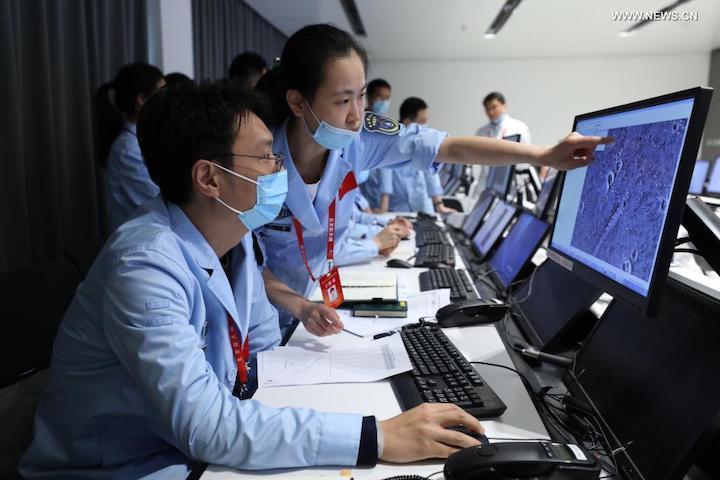
Technical personnel work at the Beijing Aerospace Control Center in Beijing, capital of China, May 15, 2021. The lander carrying China's first Mars rover has touched down on the red planet, the China National Space Administration (CNSA) confirmed on Saturday morning. It is the first time China has landed a probe on a planet other than Earth. (Xinhua/Jin Liwang)

Quelle: Xinhua
+++
China’s Zhurong Mars rover lands safely in Utopia Planitia
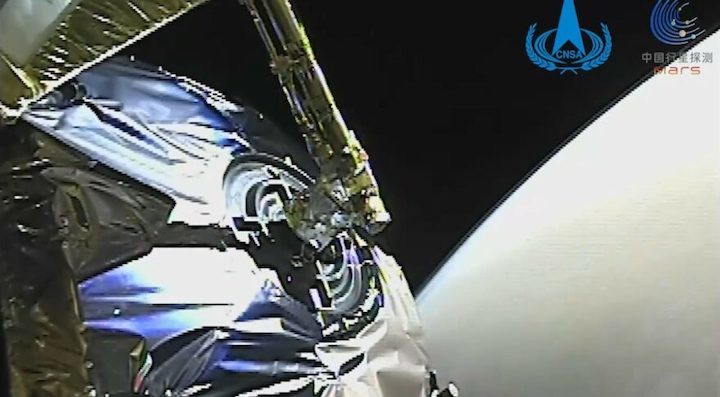
HELSINKI — China succeeded with its first planetary landing attempt Friday, safely setting down the solar powered Zhurong rover on the surface of Mars.
The 240-kilogram Zhurong rover touched down on the dunes of southern Utopia Planitia just after 7:00 p.m. Eastern May 14 after three months of preparations in orbit and around 9 minutes after entry into the Martian atmosphere.
The critical entry, descent and landing sequences were carried out successfully, with a final hazard avoidance hover phase allowing selection of a safe final landing spot.
Teams back on Earth will now prepare the rover, named after an ancient fire god, to complete a panoramic image of the landing area, perform systems checks and then descend from its landing platform and onto the Martian soil.
The rover will then begin an initial 90-day mission to explore and analyze the local area, climate, magnetic field and subsurface.
The achievement marks complete success for China’s Tianwen-1 mission, the country’s first independent interplanetary expedition which launched in July 2020 and entered Mars orbit Feb. 10.
China had previously landed on the near and far sides of the moon, in 2013 and 2019 respectively, before completing a complex lunar sample return late last year.
Zhurong is equipped with six science payloads, including a laser-induced breakdown spectroscopy instrument for analysing surface elements and minerals, panoramic and multispectral imagers, a climate station, magnetometer and a ground-penetrating radar.
It aims to return data on potential water-ice deposits, weather, topography and geology, complementing science carried out by missions from other space agencies.
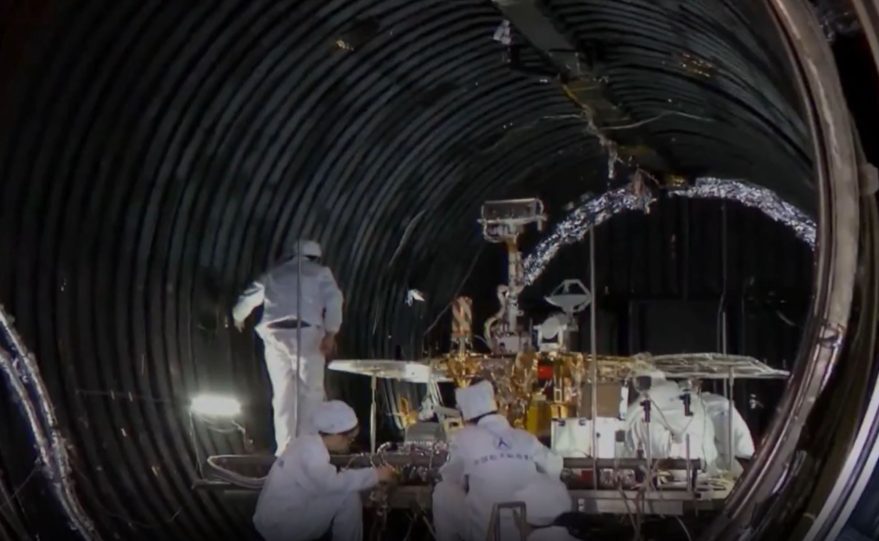
After months of collecting high-resolution imagery to map its landing area, Zhurong targeted an area inside Utopia Planitia, understood to center on coordinates of 110.318 degrees east longitude and 24.748 degrees north latitude.
Planetary scientist Long Xiao with the China University of Geosciences told SpaceNews in Februarythat “the most unique aim is to search and map the distribution of water ice on the surface and subsurface,” using sounding radars operating on both the rover and Tianwen-1 orbiter. The latter will conduct a global survey with a focus on polar and high latitude regions.
The presence of water ice at the low latitudes of Utopia Planitia could have implications for understandings of potential past or present habitability and was as future crewed Mars missions.
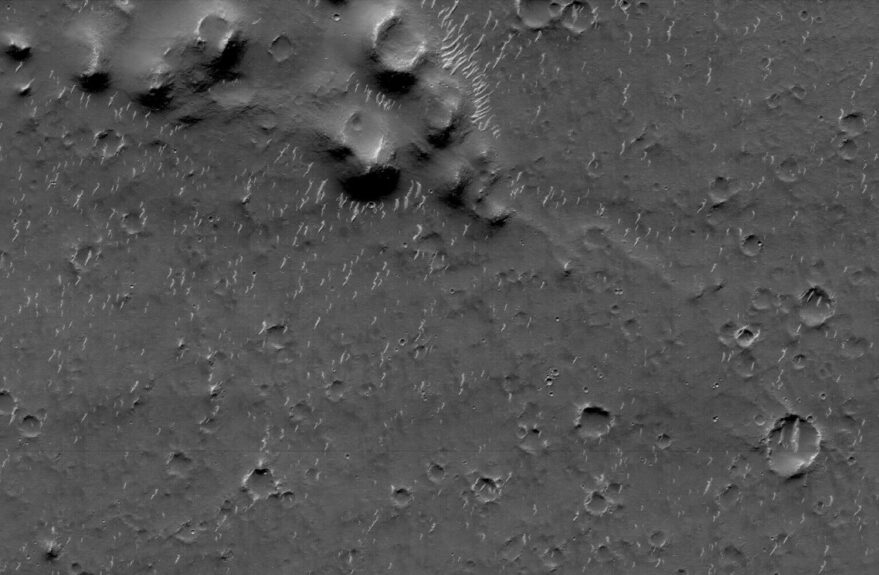
Zhurong’s climate station will also be valuable for future plans, says Maria Hieta, a space engineer at the Finnish Meteorological Institute, adding to data coming from other instruments carried by NASA’s Curiosity and Perseverance rovers and the InSight lander.
“Combining the measurements of all the weather stations will help us to better understand the Martian climate and will undoubtedly bring new information, and will also help us prepare for future human exploration,” Hieta says.
NASA’s InSight lander was also listening for signs of the landing attempt through the atmosphere and on the ground. “This is only the second time we’ve been able to try something like this, so it’s incredibly exciting,” InSight team member Benjamin Fernando told SpaceNews. “If we do manage to hear Zhurong landing, we’ll be able to use it to calibrate the measurements we’ve made of other marsquakes.”
Tianwen-1 launched from Wenchang, south China, July 23, 2020 on a Long March 5 heavy-lift rocket, combining an orbiter and rover into one launch.
The mission built on technologies and capabilities developed through the Chang’e lunar program orbiters, lander and rovers, as well as head shielding and parachute expertise from Shenzhou human spaceflight endeavors.
The European Space Agency provided China with ground support for the Launch and Early Orbit phase and later during Earth-Mars transfer phases. ESA Mars Express HRSC (High Resolution Stereo Camera) and imaging spectrometer OMEGA also provided data and expertise to support characterization and selection of the Tianwen-1 landing sites.
China’s next Mars mission is expected to be a sample return attempt for around 2028-30.

(EyesonSci)China's Tianwen-1 probe sends back Mars landing visuals

Two photos and two videos captured by China's Mars probe Tianwen-1 during and after the country's first landing on the red planet were released by the China National Space Administration (CNSA) on Wednesday.
The lander carrying a rover of the Tianwen-1 mission touched down in the southern part of Utopia Planitia, a vast plain on the northern hemisphere of Mars, on May 15, becoming the country's first probe to land on a planet other than Earth.
The first photograph, a black and white image, was taken by an obstacle avoidance camera installed in front of the Mars rover. The image shows that a ramp on the lander has been extended to the surface of Mars. The terrain of the rover's forward direction is clearly visible in the image, and the horizon of Mars appears curved due to the wide-angle lens.
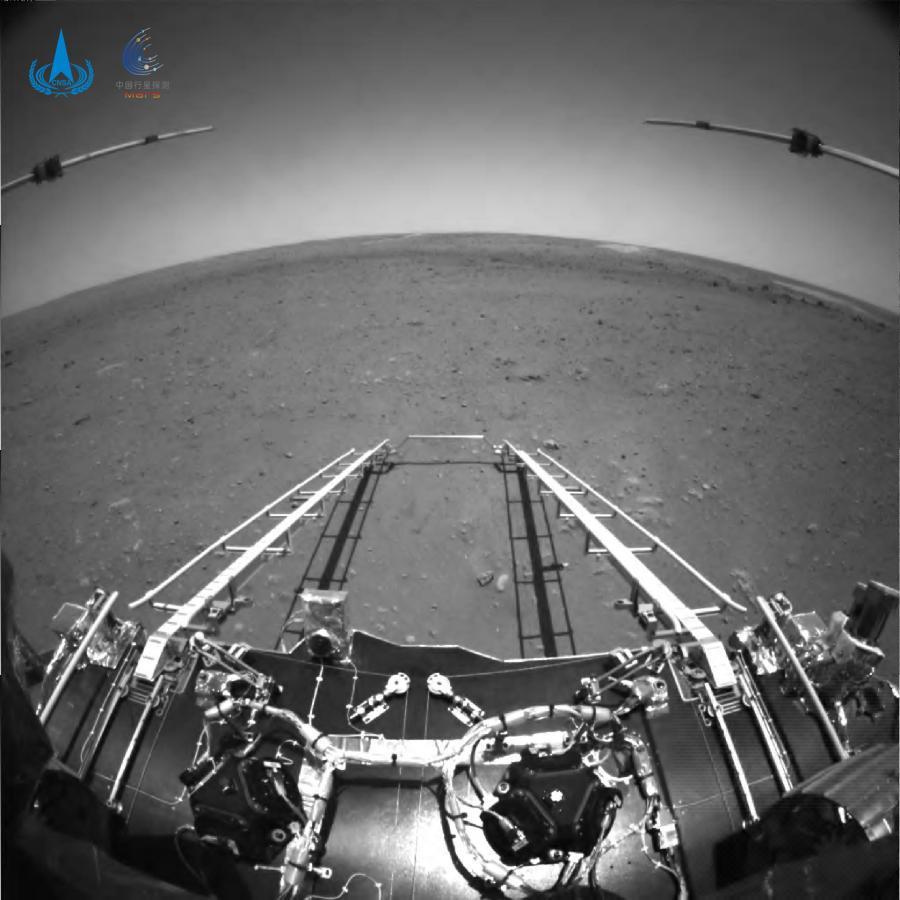
The second image, a color photo, was taken by the navigation camera fitted to the rear of the rover. The rover's solar panels and antenna are seen unfolded, and the red soil and rocks on the Martian surface are clearly visible in the image.
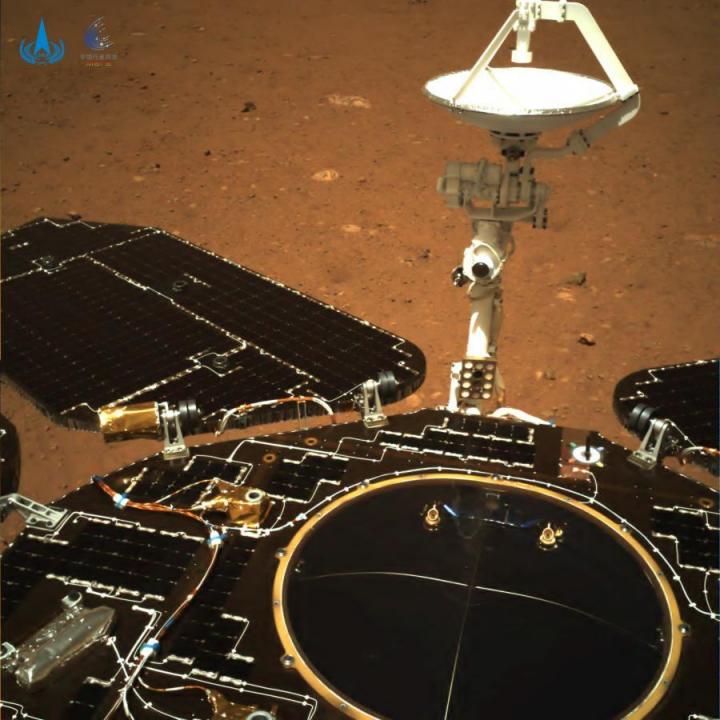
The probe also sent back a video taken by a camera on the orbiter, showing how the lander and the rover separated from the orbiter during landing.
Quelle: Xinhua
+++

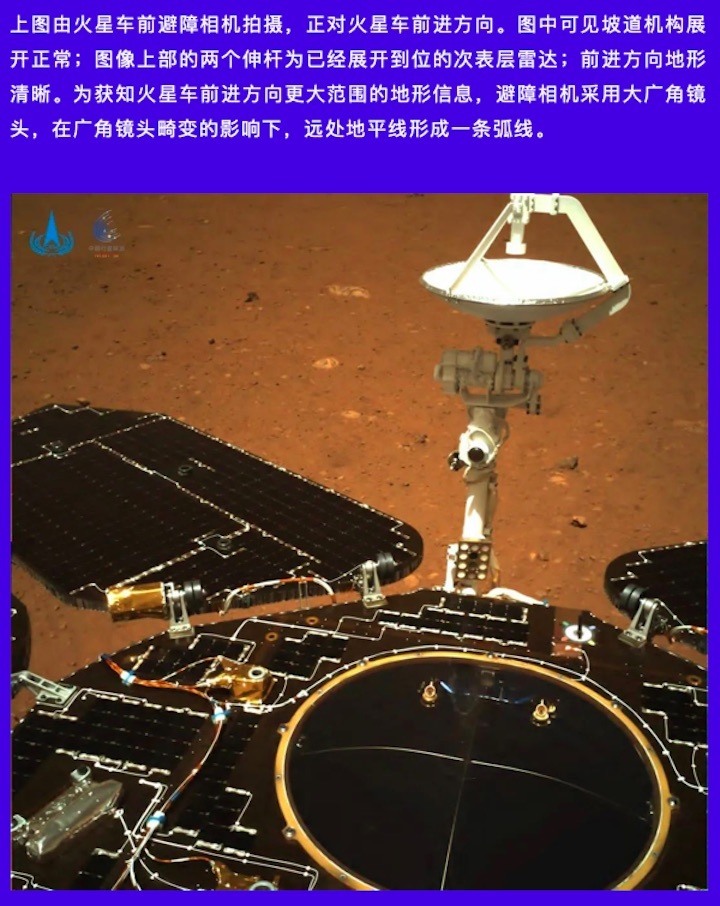
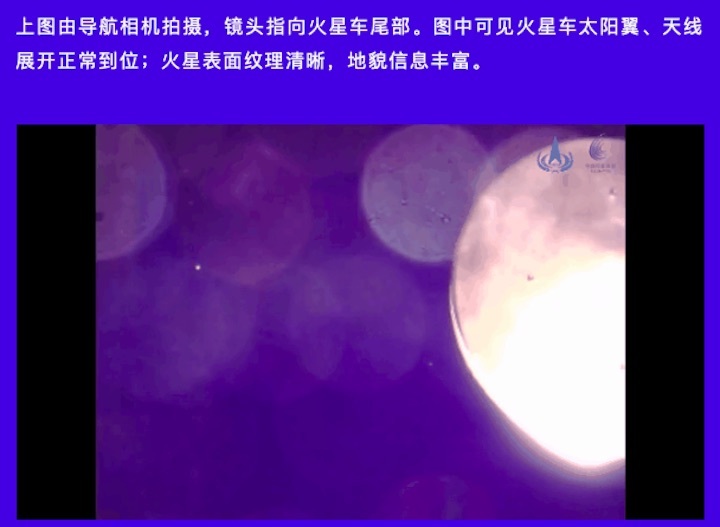
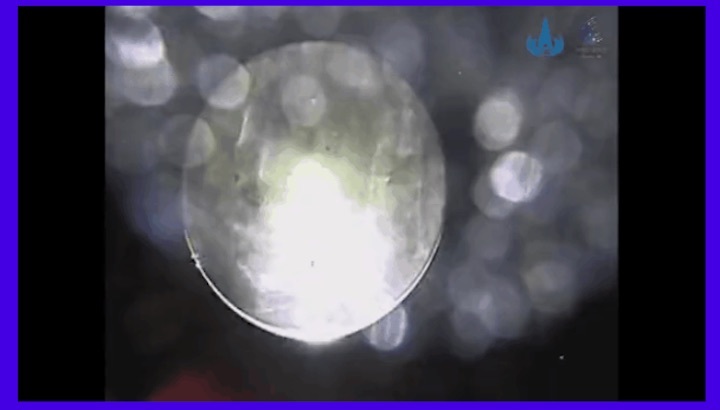
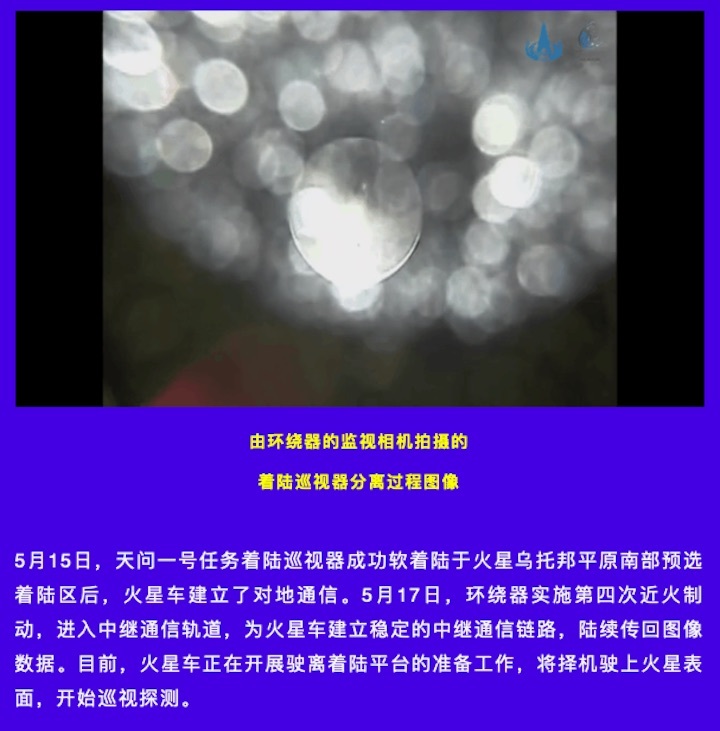
Quelle: CNSA
----
Update: 20.05.2021
.
NASA Statement on China’s Zhurong Mars Rover Photos

NASA Administrator Sen. Bill Nelson issued the following statement Wednesday after the China National Space Administration’s release of the first photos from the Zhurong Mars rover:
“Congratulations to the China National Space Administration on receiving the first images from the Zhurong Mars rover!” Nelson said. “As the international scientific community of robotic explorers on Mars grows, the United States and the world look forward to the discoveries Zhurong will make to advance humanity’s knowledge of the Red Planet. I look forward to future international discoveries, which will help inform and develop the capabilities needed to land human boots on Mars.”
CNSA’s successful landing of the Zhurong rover last week makes it only the second nation to ever land successfully on Mars. Zhurong joins active NASA missions – the Curiosity and Perseverance rovers and Insight Lander – in exploring the surface of the Red Planet.
Quelle: NASA
----
Update: 22.05.2021
.
Anyway Zhurong has rolled off her lander's ramp onto Martian surface today @ 02:40 UTC! Here's the photo proof from the rear HazCam:
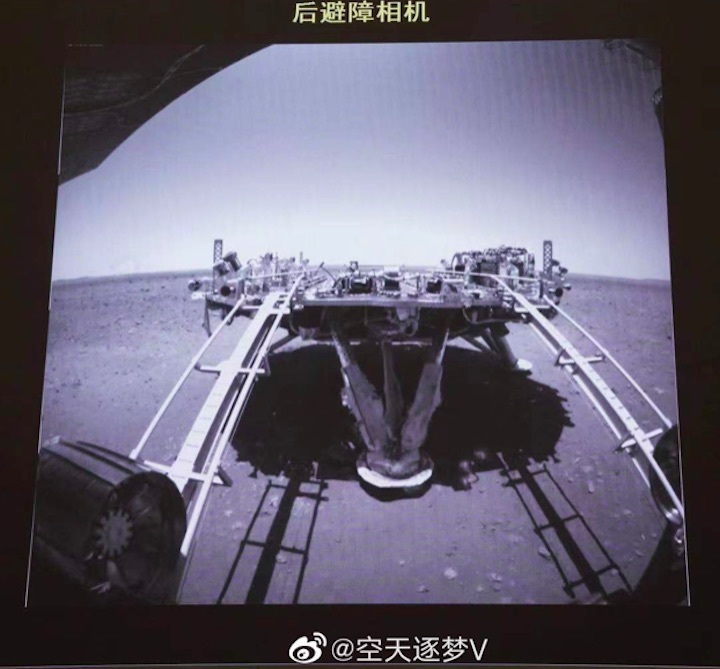
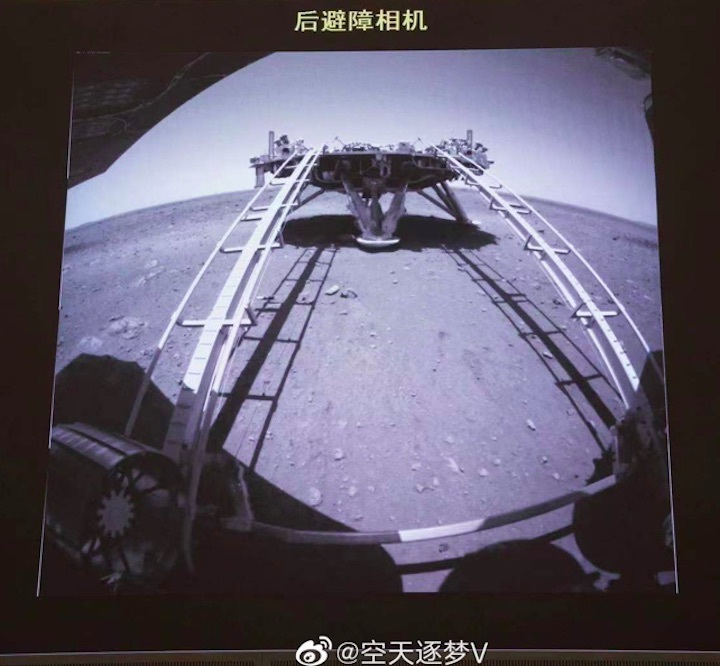
Quelle: Twitter
+++
China's Mars rover touches ground on red planet
China’s first Mars rover has driven down from its landing platform and is now roaming the surface of the red planet
BEIJING -- China’s first Mars rover has driven down from its landing platform and is now roaming the surface of the red planet, China's space administration said Saturday.
The solar-powered rover touched Martian soil at 10:40 a.m. Saturday Beijing time (0240 GMT), the China National Space Administration said.
China landed the spacecraft carrying the rover on Mars last Saturday, a technically challenging feat more difficult than a moon landing, in a first for the country. It is the second country to land and operate a spacecraft on Mars, after the United States.
Named after the Chinese god of fire, Zhurong, the rover has been running diagnostics tests for several days before it began its exploration Saturday. It is expected to be deployed for 90 days to search of evidence of life.
The U.S. also has an ongoing Mars mission, with the Perseverance rover and a tiny helicopter exploring the planet. NASA expects the rover to collect its first sample in July for return to Earth as early as 2031.
China has ambitious space plans that include launching a crewed orbital station and landing a human on the moon. China in 2019 became the first country to land a space probe on the little-explored far side of the moon, and in December returned lunar rocks to Earth for the first time since the 1970s.
Quelle: abcNews
+++
Zhurong rover rolls onto Martian surface a week after landing
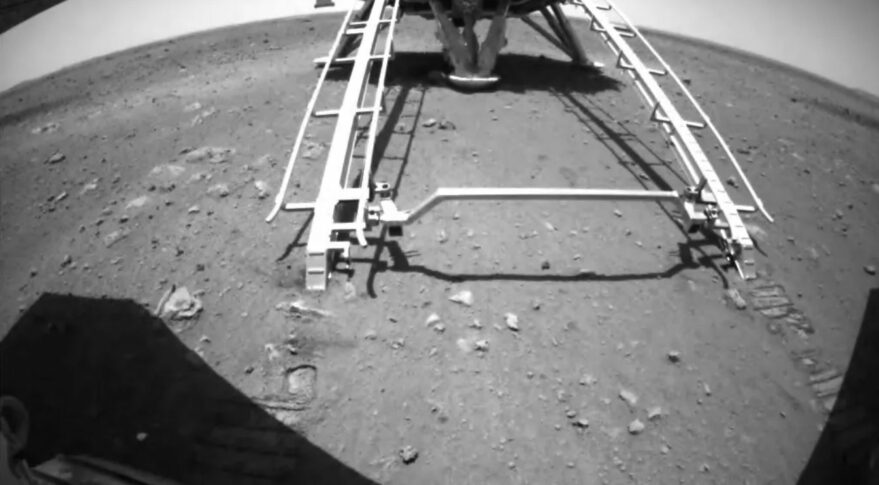
HELSINKI — China’s Zhurong rover descended onto the surface of Mars late May 21, a week after the vehicle’s historic landing in Utopia Planitia.
The China National Space Administration (CNSA) announced Saturday that the six-wheeled Zhurong had reached the surface at 10:20 p.m. Eastern Friday.
The rover will now begin science and exploration tasks in Utopia Planitia with six science payloads, including optical and multispectral cameras and ground-penetrating radar.
Zhurong had been stationed atop a landing platform since its successful May 14 entry, descent and landing.
The rover carried out automated systems checks and environmental surveying in preparation for deployment.
China’s Tianwen-1 orbiter, carried the rover to Mars, had altered its orbit Monday in order to relay data from Zhurong to Earth. Low data rates had meant that the first images from Zhurong were not released until May 19.
Zhurong is part of the Tianwen-1 mission and is China’s first independent interplanetary expedition. The spacecraft launched in July 2020 and entered Mars orbit Feb. 10.
After months of collecting high-resolution imagery to map its landing area, Zhurong targeted an area inside Utopia Planitia, understood to center on coordinates of 110.318 degrees East longitude and 24.748 degrees North latitude, successfully landing at 109.9 East and 25.1 degrees North.
The rover aims to return data on potential water-ice deposits, weather, topography and geology, complementing science carried out by missions from other space agencies.
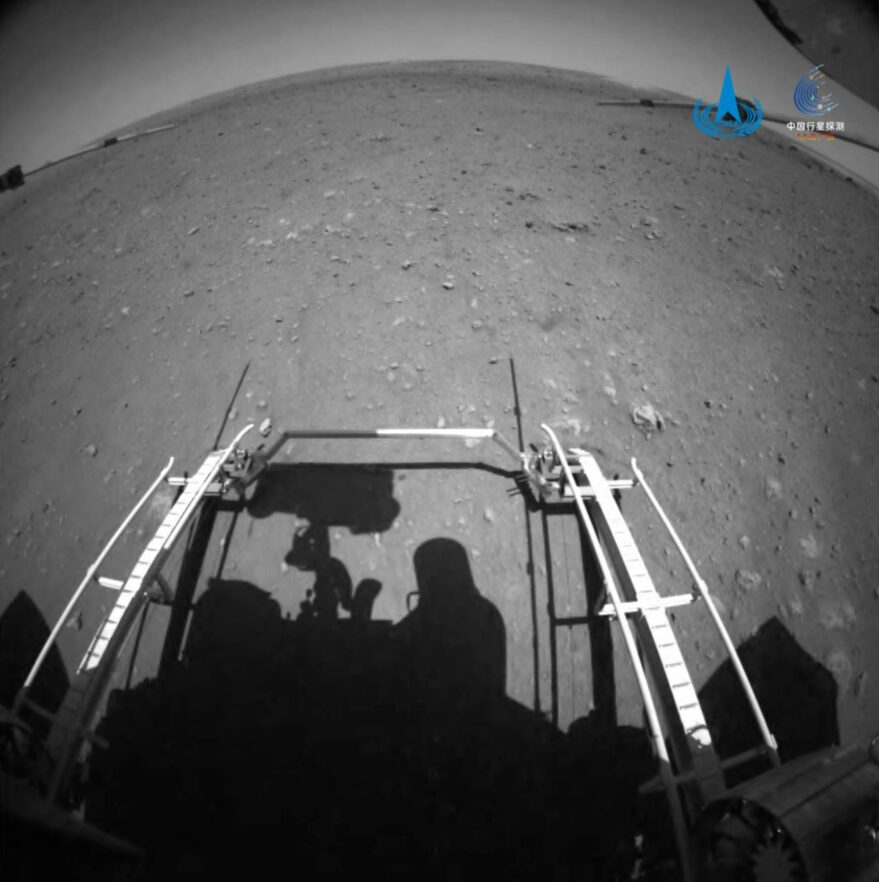
The presence of water ice at the low latitudes of Utopia Planitia could have implications for understandings of potential past or present habitability and was as future crewed Mars missions.
Zhurong has a design lifetime of 90 days during which the Tianwen-1 will act in a relay role in its current 8.2-hour orbit. The Tianwen-1 orbiter carries seven instruments of its own and is planned to enter a 7.8-hour orbit to carry out its science objectives. It is unknown if the Zhurong mission will be extended and how this will influence the plans for Tianwen-1.
The Tianwen-1 mission built on technologies and capabilities developed through the Chang’e lunar program orbiters, lander and rovers, as well as head shielding and parachute expertise from Shenzhou human spaceflight endeavors.
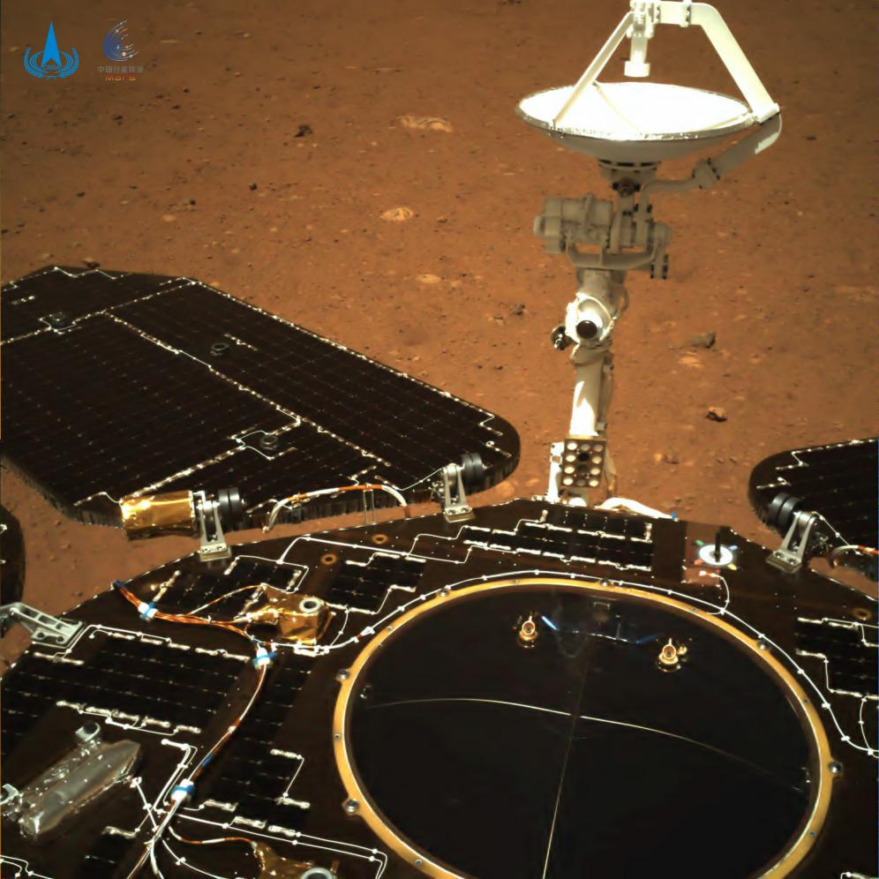
Quelle: SN
----
Update: 27.05.2021
.
Chinese rover drives onto surface of Mars
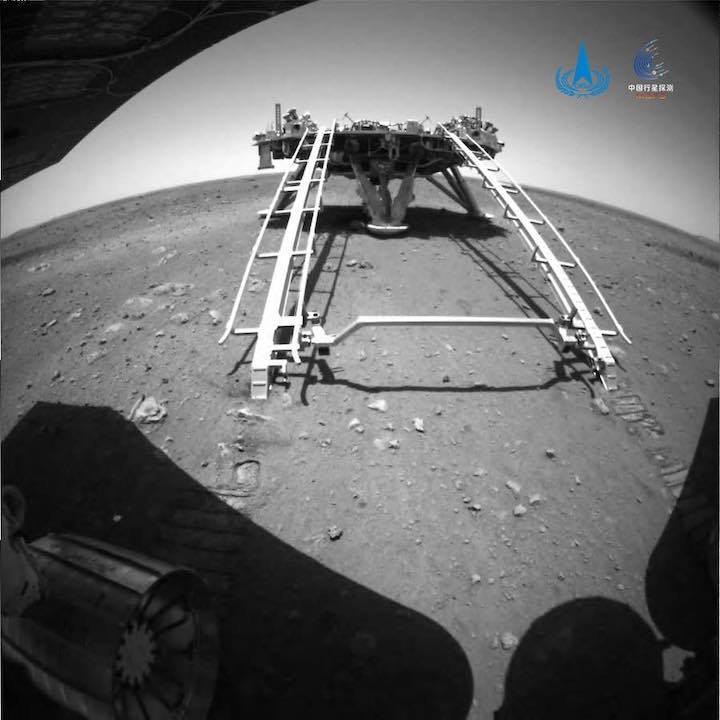
The Chinese solar-powered Zhurong rover has driven onto the surface of Mars, making China the second nation to operate a mobile robot on another planet.
The China National Space Administration said the Zhurong rover’s wheels reached the surface of Mars at 10:40 p.m. EDT Friday, May 21 (0240 GMT on May 22). The six-wheel rover rode to the Red Planet on a landing platform that successfully landed May 14, a few hours after detachment from China’s Tianwen 1 spacecraft in orbit around Mars.
Designed for a mission lasting at least three months, the Zhurong rover carries several scientific instruments to explore the mission’s landing site at Utopia Planitia, a broad plain in the northern hemisphere of Mars.
Images from the Zhurong rover show the craft surrounded by flat terrain with few large rocks.
NASA has landed five rovers on Mars since 1997, plus five stationary landers. Most recently, NASA’s Perseverance rover landed on Mars in February on a mission to collect rock samples for eventual return to Earth. Perseverance also delivered NASA’s Ingenuity helicopter to the Red Planet, setting the stage for a series of historic test flights in the Martian atmosphere beginning last month.
China’s Zhurong rover weighed about 529 pounds (240 kilometers) in Earth’s gravity, and stands about 6 feet (1.8 meters) tall. The Chinese craft is slightly larger than NASA’s defunct Spirit and Opportunity rovers, which landed on the Red Planet in 2004. Zhurong is significantly smaller than NASA’s Curiosity and Perseverance rovers currently driving across the surface of Mars.
In addition to three-dimensional cameras and a subsurface radar to search for underground water ice, the Zhurong rover carries sensors to measure the composition of Martian rocks, a magnetic field monitor, and a weather station to collect atmospheric data at the Utopia Planitia location.
China’s state-run Xinhua news agency said the Zhurong rover can travel at a maximum speed of about 660 feet (200 meters) per hour, equivalent to 0.12 mph. In reality, the rover will likely travel much shorter distances each day.
Zhurong can climb slopes up to 20 degrees, and overcome obstacles as tall as 1 foot (30 centimeters), Xinhua said.
The rover’s active suspension system allows the craft to inchworm across the surface of Mars and walk sideways like a crab, Xinhua said. All six wheels can turn in any direction, a capability that could help the rover free itself from sand traps.
Chinese engineers designed the solar panels on the Zhurong rover to make it difficult for dust to accumulate on the power-generating array, according to Xinhua. The craft also has heaters to help it survive cold Martian nights.
Tianwen 1 became the first Chinese mission to enter orbit around Mars when it arrived in February, making China the sixth country or space agency to have a probe orbiting the Red Planet, following the United States, the former Soviet Union, the European Space Agency, India, and the United Arab Emirates.
The robotic mission departed Earth last July on a Long March 5 rocket, the most powerful launcher in China’s fleet.
The Tianwen 1 orbiter is designed to function at last one Martian, or about two Earth years. The orbiter has its own scientific instruments and will relay signals between the Zhurong rover and mission controllers in China.
Quelle: SN
----
Update: 9.06.2021
.
China releases new Mars image taken by Tianwen-1 probe
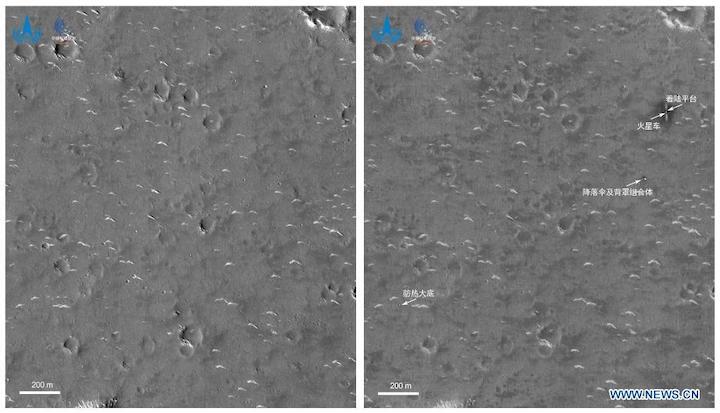
A new image released by the China National Space Administration (CNSA), taken by a high-resolution camera installed on the orbiter of Tianwen-1 at 6 p.m. on June 2 (Beijing Time), shows the landing platform and the Zhurong Mars rover on the Martian surface. The CNSA on Monday released a new image taken by the Tianwen-1 probe, showing the country's first Mars rover and its landing platform on the red planet's surface. (China National Space Administration/Handout via Xinhua)
The China National Space Administration (CNSA) Monday released a new image taken by the Tianwen-1 probe, showing the country's first Mars rover and its landing platform on the red planet's surface.
In the image, taken by a high-resolution camera installed on the orbiter of Tianwen-1 at 6 p.m. on June 2 (Beijing Time), two bright spots are visible in the upper right corner. The larger one is the landing platform, and the smaller one is the Zhurong Mars rover, the CNSA said.
China's Tianwen-1 mission, consisting of an orbiter, a lander, and a rover, was launched on July 23, 2020. The lander carrying the rover touched down in the southern part of Utopia Planitia, a vast plain in the northern hemisphere of Mars, on May 15.
The rover Zhurong drove down from its landing platform to the Martian surface on May 22, starting its exploration of the red planet, and making China the second country after the United States to land and operate a rover on Mars.
The dark area surrounding the landing platform might be caused by the influence of the engine plume during landing. The symmetrical bright stripes in the north-south direction of the landing platform might be from fine dust when the landing platform emptied the remaining fuel after landing, the CNSA said.
The bright spots in the center of the image are the back cover of the entry capsule and the parachute jettisoned during the landing. Another bright spot in the lower left of the image is the heat shield of the entry capsule, the CNSA said.
As of June 6, the rover Zhurong has been working on the surface of Mars for 23 Martian days to detect the environment, move around the surface, and carry out scientific exploration. A Martian day is approximately 40 minutes longer than a day on Earth.
All scientific equipment aboard the rover is turned on to collect data. The orbiter operates in a relay orbit with a cycle of 8.2 hours, providing relay communication for the scientific exploration of the Mars rover.
The rover Zhurong is named after the god of fire in ancient Chinese mythology. The name echoes with the Chinese name for the red planet, Huoxing (the fire planet), while the name of the mission, Tianwen, means Questions to Heaven. It is the title of a poem by the ancient Chinese poet Qu Yuan (circa 340-278 BC).
With an expected lifespan of at least 90 Martian days (about three months on Earth), Zhurong will record the Martian landscape with high-resolution three-dimensional images and analyze the material composition of the planet's surface. It will also detect its sub-surface structure and magnetic field, search for traces of ice and observe the surrounding meteorological environment.
The orbiter, with a design life of one Martian year (about 687 days on Earth), will relay communications for the rover while conducting its own scientific detection operations. Enditem
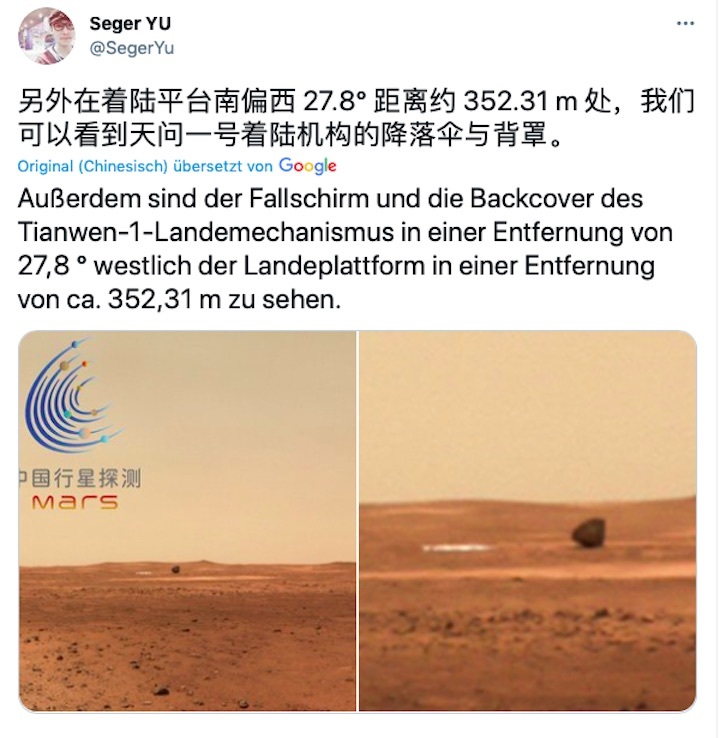
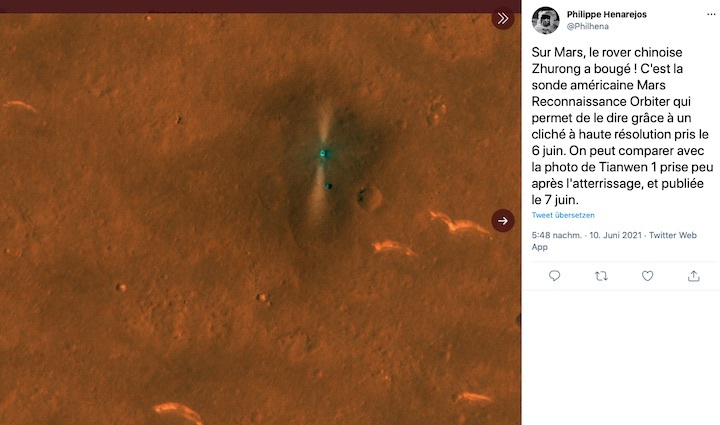
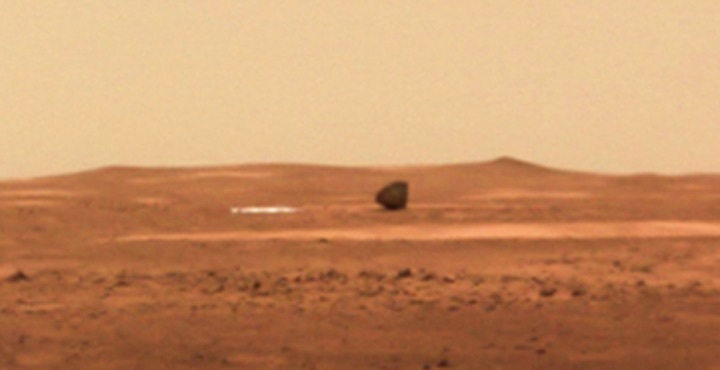

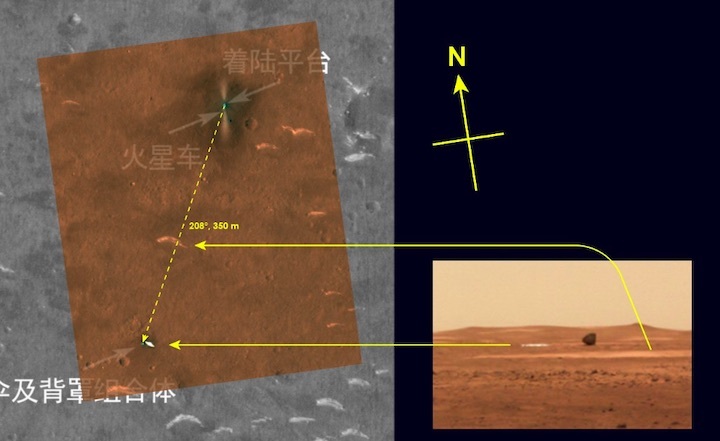

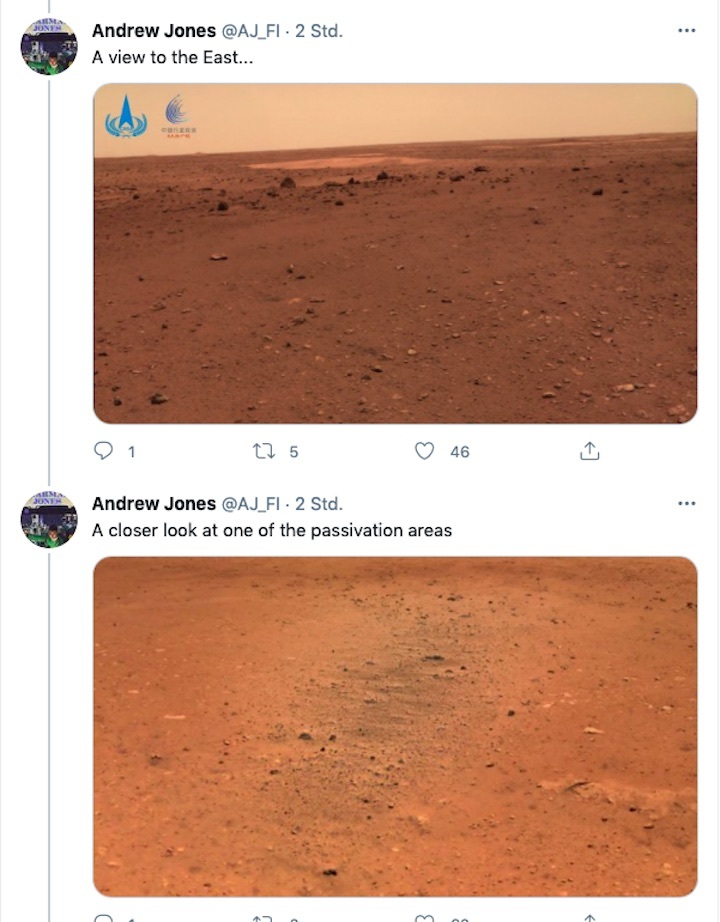
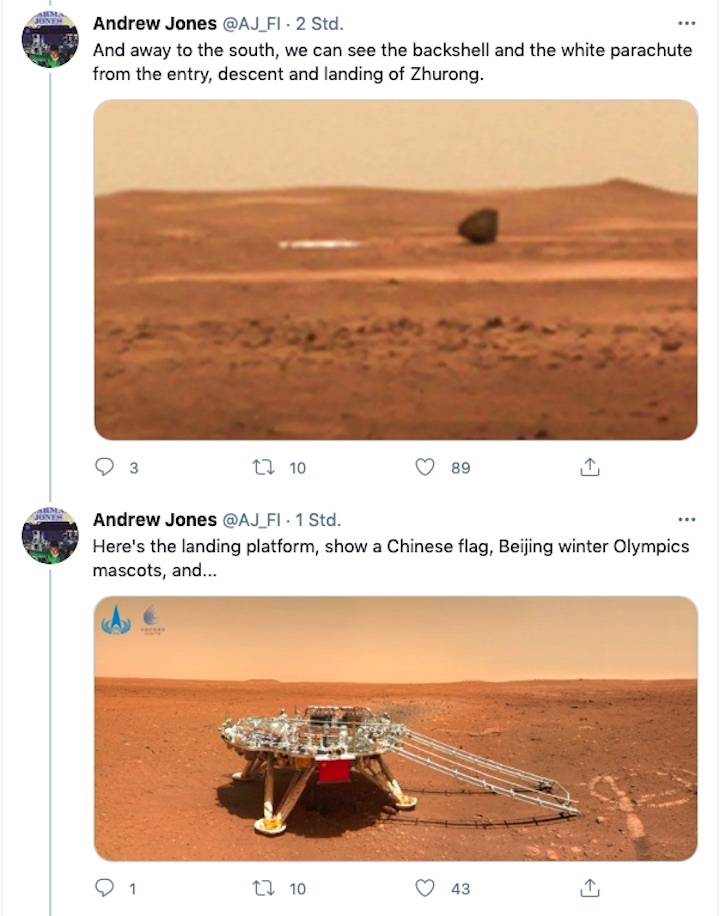
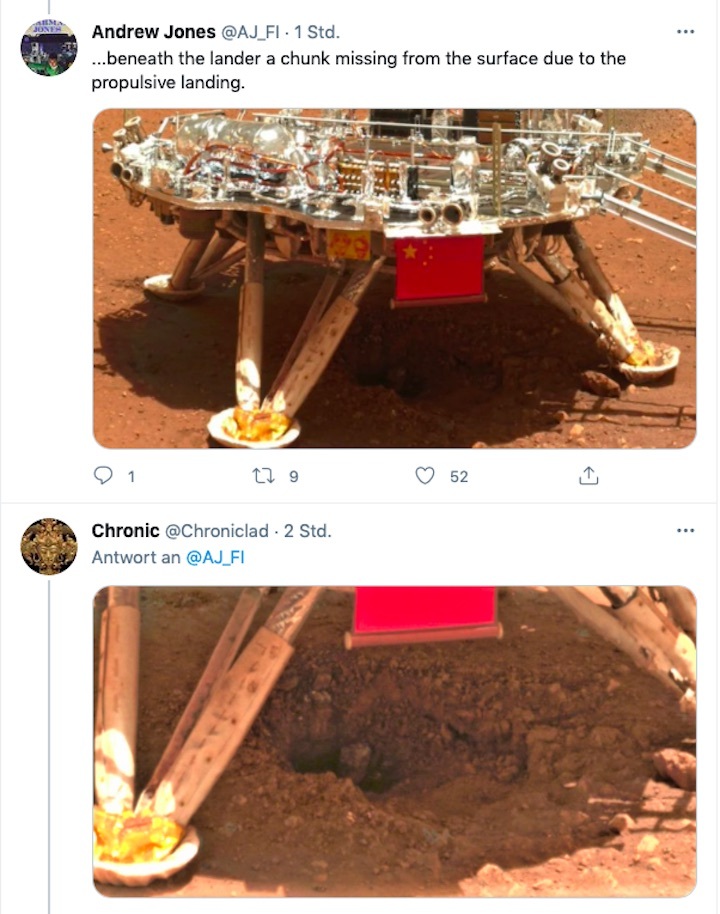

US satellite looks down on China's Zhurong Mars rover
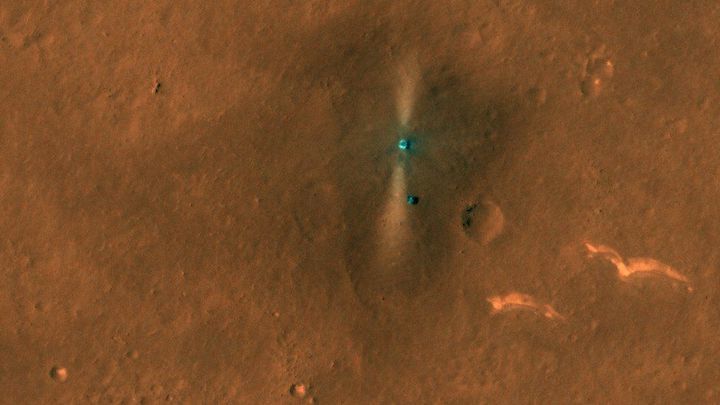
An American satellite has pictured the new Chinese rover on the surface of Mars.
The image acquired by the Mars Reconnaissance Orbiter (MRO) shows the Zhurong robot a short distance in front of its landing platform.
It's the first independent confirmation of the Chinese mission in action.
The HiRise camera on MRO also detected the parachute and components of the capsule (backshell and heatshield) that brought Zhurong through the atmosphere.
The rover landed on 14 May in a region of the planet called Utopia Planitia. This is a vast terrain in Mars' northern hemisphere.
After releasing pictures of the vehicle rolling down the platform's ramp a few days later, the Chinese authorities then went into a long period of quiet before providing their own black-and-white satellite view of the landing site earlier this week.
Now, MRO-HiRise has followed up with a colour perspective.
Chinese scientists hope get at least 90 Martian days of service out of Zhurong
The robot looks a lot like the US space agency's (Nasa) Spirit and Opportunity vehicles from the 2000s.
It weighs some 240kg. A tall mast carries cameras to take pictures and aid navigation; five additional instruments will investigate the mineralogy of local rocks and the general nature of the environment, including the weather.
Like the current American rovers (Curiosity and Perseverance), Zhurong has a laser tool to zap rocks to assess their chemistry. It also has a radar to look for sub-surface water-ice - a capability it shares with Perseverance.
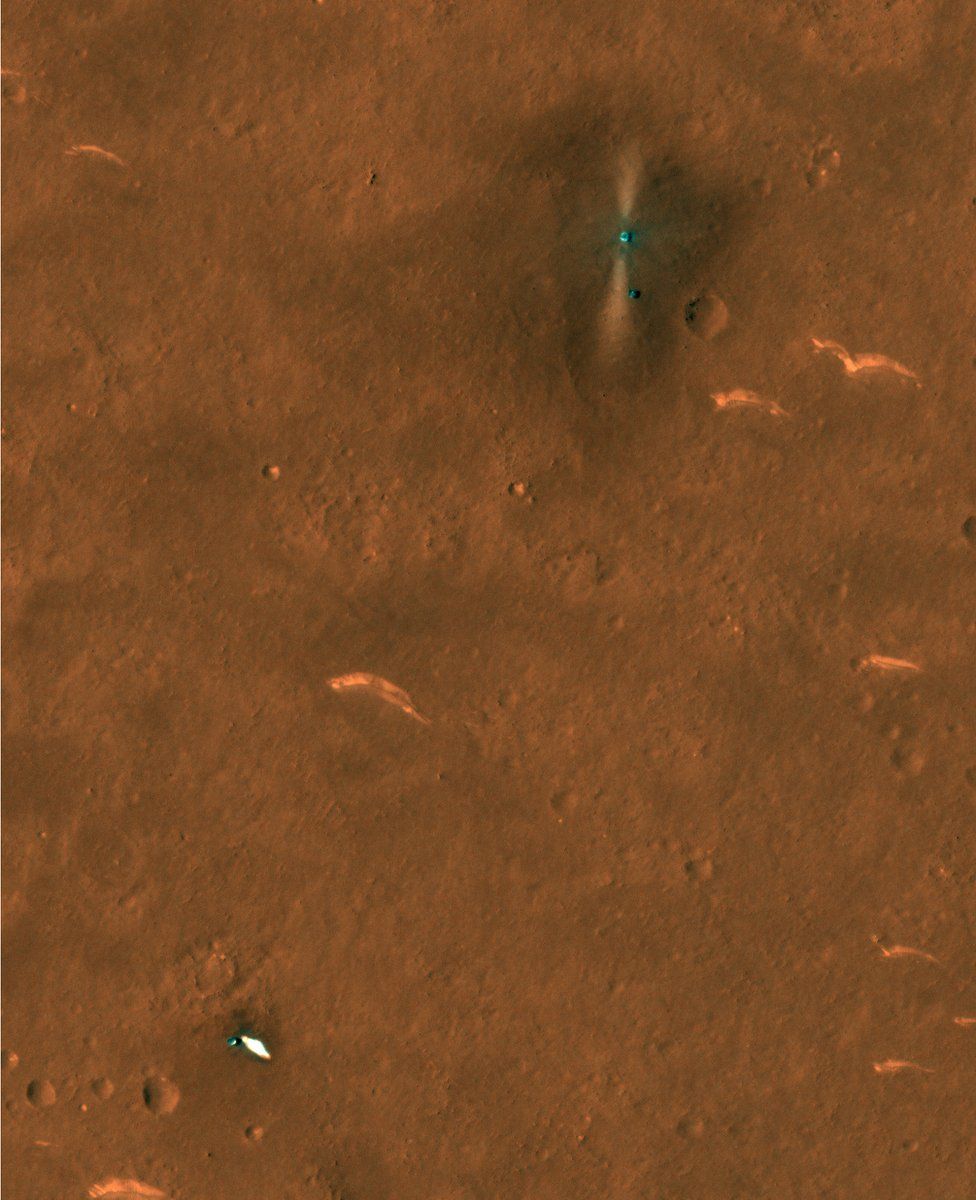 IMAGE COPYRIGHTNASA/JPL/UARIZONA
IMAGE COPYRIGHTNASA/JPL/UARIZONA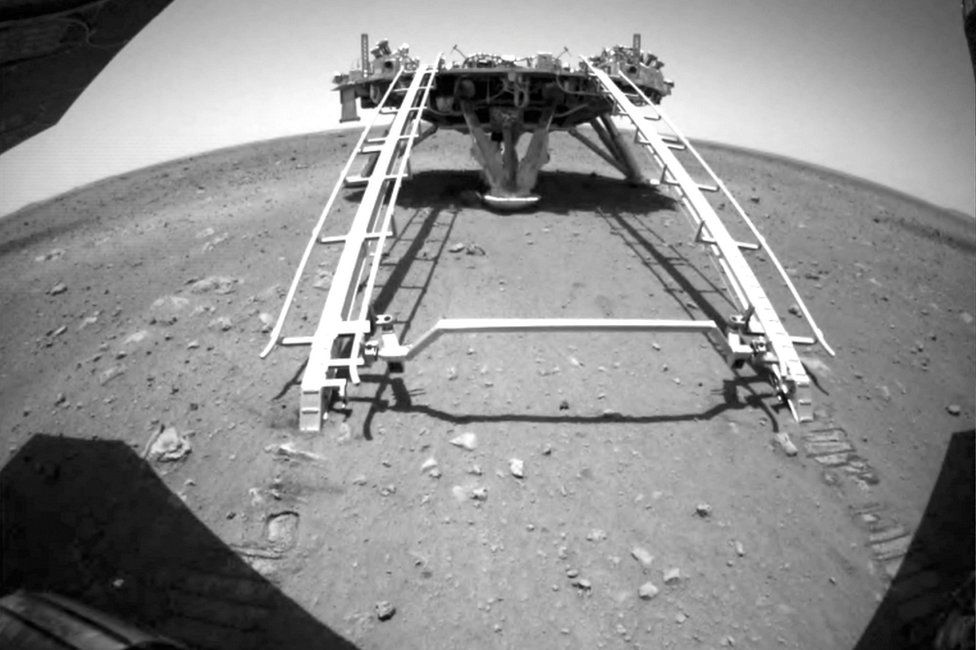 IMAGE COPYRIGHTREUTERS
IMAGE COPYRIGHTREUTERS IMAGE COPYRIGHTCNSA
IMAGE COPYRIGHTCNSA